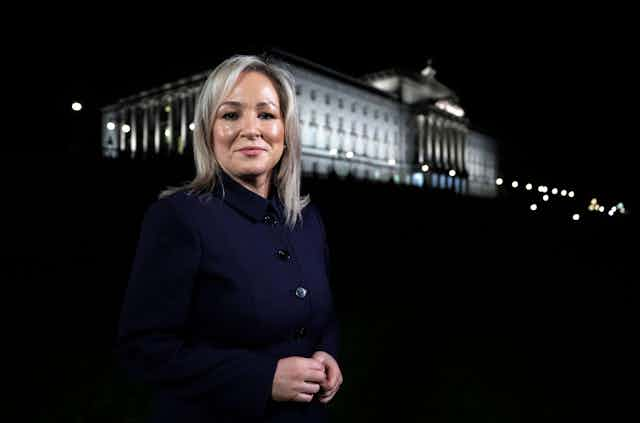Addressing the newly restored Northern Ireland Assembly, Sinn Féin First Minister Michelle O’Neill assured everyone that she would be working equally for “Catholics, Protestants and dissenters”.
This iconic quote from the founder of Irish Republicanism, Theobald Wolfe Tone, needs no contextualisation in Ireland. It was not just meant to reassure those among unionists who might have misgivings about a Sinn Féin-led government. O’Neill was also addressing her own rank and file. She was guaranteeing that while the party will do its utmost to make Northern Ireland work, it has not lost sight of the ultimate prize – Irish unity.
In a carefully crafted speech full of optimistic prophecies, O’Neill announced a “new dawn” and the start of a “decade of opportunity” for Northern Ireland. She wasted little time in clarifying that she believes there will be a referendum on Irish unity within the next decade. Sinn Féin party president Mary Lou McDonald echoed the same sentiments almost immediately in Dublin.
The Good Friday Agreement provided that the governance of Northern Ireland is predicated on a power-sharing system. While this theoretically made it possible for the party most opposed to the very existence of Northern Ireland, Sinn Féin, to lead its government, it was an unimaginable scenario at the turn of the century. Unionism remained solid and politically dominant in a system designed to make it so. Sinn Féin equally still had a number of obstacles to overcome on its road to respectability and power – not least shedding its controversial image of a party closely linked to the IRA.
Throughout the peace process, Sinn Féin developed a carefully crafted, two-pronged strategy. It would keep the party strongly rooted in its traditional message while developing a socio-economic programme that could win over the electorate from both constituencies. This has now started to pay off. Sinn Féin surged to win the popular vote in the 2020 general election in Ireland, even though other parties went on to form the government.
The trend was confirmed in the 2022 Northern Ireland assembly election, when it became the biggest party for the first time, giving O'Neill the right to claim the position of first minister. But the Democratic Unionist Party made their participation in the executive conditional on the renegotiation of the 2021 Brexit deal. A more recent deal brokered by prime minister Rishi Sunak and the EU broke the deadlock, with the DUP agreeing to participate in a Sinn Féin-led government.
Meanwhile, in the Republic, under the leadership of Mary Lou MacDonald, and a team of high-profile spokespeople on issues such as housing (Eoin Ó Broin having made a name for himself as an expert in the field) and finance (Pierce Doherty’s alternative 2024 budget was described by Irish Times political editor Pat Leahy as “comprehensive and painstakingly costed”), the party reinvented itself. It succeeded in providing a credible, leftwing alternative to the two-party system that had seen Fianna Fáil and Fine Gael dominate Irish politics since independence.
In government and opposition
As the only political party organised throughout the island (with the exception of People Before Profit, which holds four seats in the Republic and one in Northern Ireland), much of Sinn Féin’s work on one side of the border is scrutinised on the other.

Being in government on one side and in opposition on the other, all at the same time, will therefore be a delicate balance to sustain. In the Republic, Sinn Féin has kept the two main parties, Fine Gael and Fianna Fáil, on their toes. But while it has retained its lead over its two rivals, opinion polls show that the gap is slowly narrowing. Sinn Féin dropped from an all-time high of 33% in September 2023 to 27% in January 2024 – though it is still ahead of the other parties by a comfortable margin. Sinn Féin’s capacity to prove that it can govern consensually and efficiently in an environment as politically divisive as Northern Ireland will be a useful test ahead of the next general election in the Republic.
In the North, the work of the newly nominated executive will be focused on bread-and-butter issues, such as addressing the crisis in the NHS, which is reaching breaking point. The political vacuum created by the Democratic Unionist Party’s boycott of the institutions has compounded the problems faced by an ailing economy which lags behind the Republic in terms of salaries and living standards. The British government has offered a £3.3bn funding package as part of the deal to restore power sharing in Northern Ireland and this will undoubtedly help to address the more immediate questions of public sector pay, which has stagnated since the start of the decade and is the lowest in the UK.
Now that it holds the key ministries of finance, economy and infrastructure, Sinn Féin will have the opportunity (or face the challenge) to demonstrate its ability to make a difference. During their visit to Belfast to mark the restoration of the power-sharing executive, on February 5, Irish Prime Minister (Taoiseach) Leo Varadkar and his British counterpart Sunak played down the prospects of a united Ireland and insisted on the importance of day-to-day matters.
Indeed, only the secretary of state for Northern Ireland can decide on holding of a referendum on the constitutional future of Northern Ireland. But Sinn Féin is determined to make this happen. O'Neill has pledged that she will not ask anyone in Northern Ireland to surrender their identity. However,‘ we can expect her and her colleagues to continue to put Irish unity at the top of the agenda.

